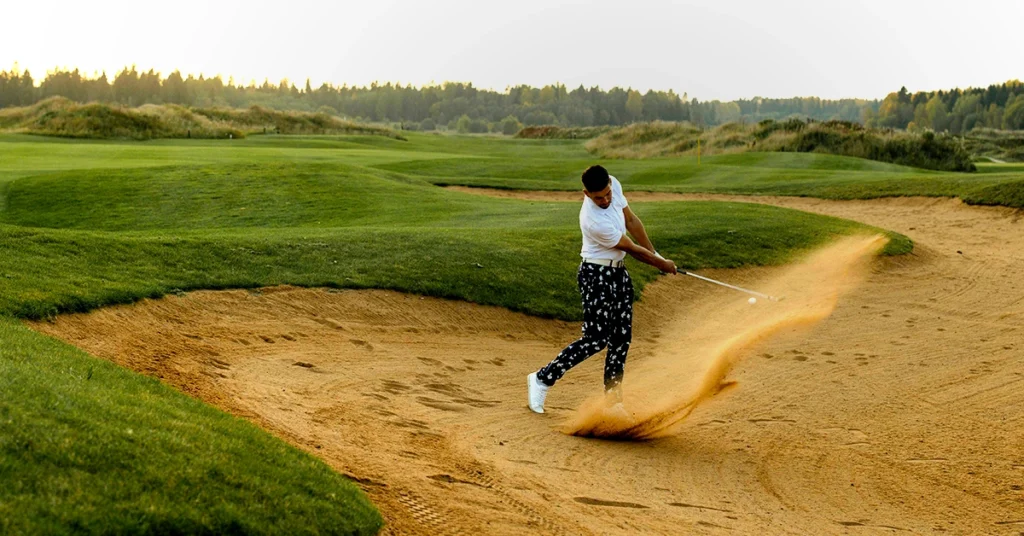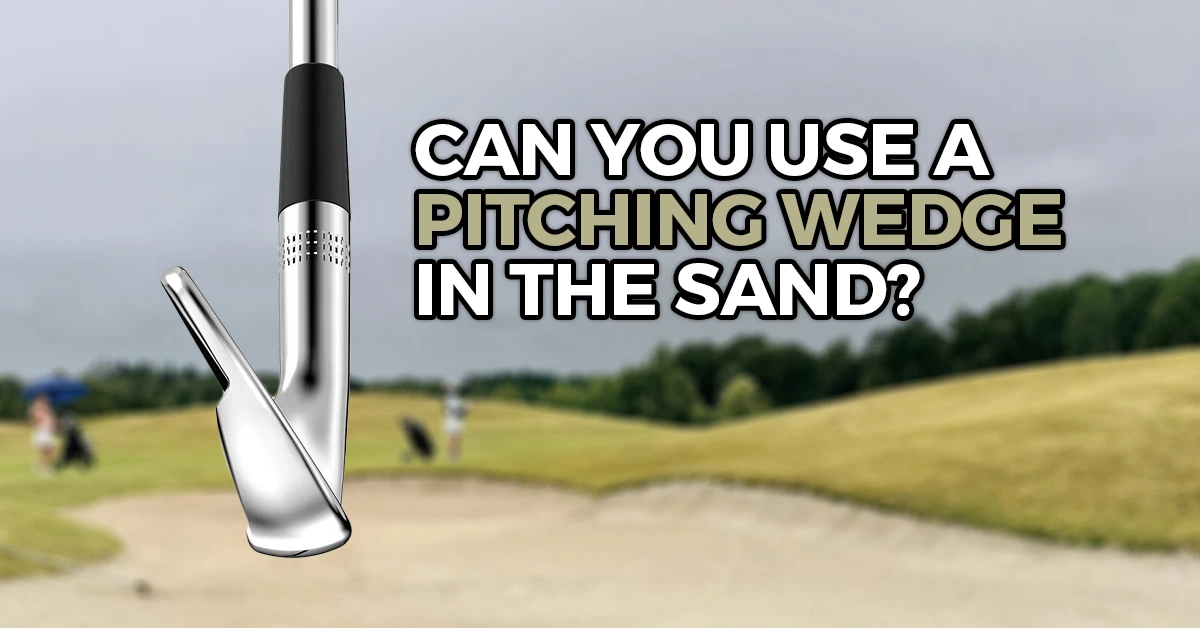Whether you’re a seasoned golfer or just a beginner starting to navigate the game’s difficulties, the appeal of the bunker offers players a challenge and a chance to demonstrate their skill and expertise.
The Wedge is an essential part of the Iron Club, and The Pitching Wedge is a reliable tool in any golfer’s bag for approach shots and delicate chip shots near the green. However, what about the unforgiving sand traps?
As a golfer trying to enhance your game, the question arises: Can you use a Pitching Wedge (PW)in the sand?
In short, using a Pitching Wedge in the sand is not ideal or recommended. Let’s explore this in detail, and by the end of this guide, you will learn: Can you use a Pitching Wedge(PW) in the sand? , Loft of Pitching Wedge, Difference Between Pitching Wedge and Sand Wedge.
So, let’s devolve into the world of golf and find the complete answer: “Can you use a Pitching Wedge in the sand?
Can you use a Pitching Wedge in the Sand?
The frustration of trying to escape a sand trap is well-known to those who have experienced it. It can also be considerably more challenging if you don’t have the appropriate club. Choosing the right clubs in any situation at a course is crucial.
Then, Can you use a pitching wedge in the sand? You can use a pitching wedge in the sand, but there are better choices or best Wedge when playing shots out through a bunker.
The Pitching Wedge is mainly designed for short approach shots and typically has less loft than sand-specific wedges. Therefore, if you’re considering using a pitching wedge in the sand, you should prefer using a wedge that is particular to the sand, like a sand wedge or a lob wedge.
Sand wedges are specifically designed for playing shots from bunkers. They generally have more bounce, a wider sole, and a higher loft. The higher loft makes it easier for golfers to get the ball out of the sand, and The wider sole prevents the club from going too far into the sand.
Using a pitching wedge in the sand may cause the ball to travel farther and have less spin, making it harder to control the distance and stop the ball close to the hole.
So, if you find yourself in a bunker, It is recommended to use a sand wedge or lob wedge. Using a pitching wedge in the sand may cause the ball to travel away and have less spin, making it harder for golfers to control the distance and stop the ball close to the hole.
The Loft of a Pitching Wedge:

After knowing Can you use a pitching wedge in the sand? you are also wandering about the loft of a pitching wedge. The loft of a pitching wedge can differ between golf club models and manufacturers, But in general, the attic of a Pitching Wedge ranges between 46 to 48 degrees. The pitching wedge has one of the lowest lofts among all the golf clubs.
You would use a pitching wedge on longer shots where spin and height are not required.
Difference Between a Pitching Wedge(PW) and a Sand Wedge(SW):
Pitching Wedge
- PW has a lower loft than other wedges, typically ranging between 46 to 48 degrees.
- It is designed for approach shots.
- PW has a narrower sole and less bounce.
- PW offers improved distance control for approach shots from a range of lies, enabling players to hit the ball precisely at a target distance.
Sand Wedge
- SW has a higher loft, typically ranging between 54 to 58 degrees.
- It is designed for shots from a bunker.
- SW has a wider sole and increased bounce.
- SW is utilized for shorter shots, particularly from sand bunkers, where obtaining accurate distance control is less important than getting the ball out.
However, the pitching and sand wedge have different functions and purposes in a short game. While the Sand Wedge is specifically designed to handle bunker situations and shots that require more loft around the green, the Pitching Wedge is a versatile club for approach shots.
Benefits of Pitching Wedge(PW):
Golfers can benefit from various Pitching Wedge (PW) uses, particularly in approach shots and the short game. The following are the benefits of Pitching Wedges:
- For approach shots, the Pitching Wedge is made to offer superior distance control.
- It allows golfers to target the green at precise distances during full swings accurately.
- A pitching wedge is a versatile wedge.
- Golfers highly appreciate the consistency of pitching wedges.
- It is a common transition tool between irons and higher-lofted wedges.
In summary, PW is a useful tool that gives golfers accurate distance control, adaptability, and the capacity of golfer to manage a range of shots in various conditions on the course.
Benefits of Sand Wedge(SW):
The Sand Wedge (SW) is a specialty golf club made for particular circumstances, especially when hitting shots out of sand bunkers. The following are the benefits of Sand Wedges:
- It has the effectiveness in navigating sand bunkers.
- It has an improved sole design, allowing more bounce and a wider sole.
- It has a higher loft that provides a high trajectory, which is beneficial for shots on the greens.
The Sand Wedge is a specialty club that offers unique advantages, especially in bunker play and other short-game situations. Its design is tailored to provide golfers with the tools to navigate challenging lies, achieve higher trajectories, and enhance precision around the green.
Best Pitching Wedge for Golfers:
Titleist Vokey Design SM9 Tour Chrome Wedge 54.14F

Pros
- It provides a superb feel.
- It has a great look.
- It allows you to control trajectory.
- It provides exceptional forgiveness.
Cons
- It is not a budget-friendly club.
Titleist Vokey SM9 Wedge is expertly designed with features like a compact clubhead, controlled flight, common spin, and a buttery-soft feel. All these features make Titleist Vokey SM9 Wedge the best choice for golfers to consider.
I tested many Vokey wedges, but SM9 was the most forgiving Wedge for approach shots. This compassionate nature makes Titleist Vokey ideal for Mid-handicappers who might have avoided the Wedge in the past due to their unforgiving nature.
It allows golfers to target the green at precise distances during full swings accurately.
On shorter approach shots, the Wedge produced a controlled flight and shot-stopping spin thanks to the clever placement of the CG. Low handicappers will value this feature since it keeps you from losing control of your strike and making ballooned wedge shots.
It has a loft range between 46 to 62 degrees. Lastly, an F-grind design is offered for the pitching and gap wedges. Four to five grind options are available for steep, neutral, and shallow attack angles on the sand and lob wedges.
Titleist Vokey SM9 Wedge is one of the best pitching wedge tools that give golfers accurate distance control, adaptability, and the capacity to golfer, to manage a range of shots in various conditions on the course.
Conclusions:
To sum up, Can you use a Pitching Wedge in the sand? You can use a pitching wedge in the sand, but there are better choices or best wedges when playing shots out through a bunker.
Some golfers may find it ideal to use PW in the sand, depending on their needs and preferences. But a dedicated Sand Wedge or Lob Wedge is still the better choice for most players, especially those who want the best possible performance out of their bunkers.
Additionally, PW is a useful tool that gives golfers accurate distance control, adaptability, and the capacity of golfer to manage a range of shots in various conditions on the course. Still, there are better choices to use in sand.
I am sure now after reading a detailed guide on whether Can you use a pitching wedge in the sand, you are all clear about whether you should use a pitching wedge in the sand or not.
You may also like How many wedges should you carry
and How to stop swaying in a golf swing
Frequently Asked Questions:
Can I use a Pitching Wedge(PW) in the sand?
A pitching wedge works well in the sand, but better options exist for playing shots out through a bunker. Compared to wedges made specifically for sand, the pitching wedge is usually less lofted and is primarily intended for short approach shots.
What are the disadvantages of using a pitching wedge in sand?
Pitching wedge shots may have a lower trajectory and less spin, which makes it more challenging to control the distance and stop the ball on the green. Its narrower sole could also dig into the sand, producing inconsistent performance.


